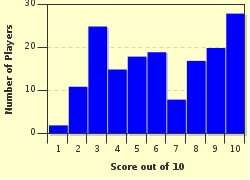Quiz Answer Key and Fun Facts
1. The process of building an object on the computer within 3D space is most often called what?
2. Once the character or object is built in the program, what is the process called of adding color, reflection, transparency, translucency and roughness?
3. Basic shapes, such as cubes, cylinders and circles that are used to build an object are called what?
4. To create real world reflections in most software packages, the "reflection" is actually made up of three parts. Can you guess which of the following is not part of the reflection channel?
5. Unlike traditional animation, in the world of 3D, the computer interpolates the movement between poses rather than having an artist manually animate each and every frame. What are these key poses called?
6. Light in the real world continually bounces off of objects to illuminate an area. In the 3D software, this real world light simulation is extremely render intensive on the computer, but produces beautiful results. Can you guess what most software dubs this simulation?
7. When building an object in 3D space, it is a wise idea to build it to the scale of its real world counterpart.
8. Everything in a 3D scene has to be either manually animated or calculated by the computer, as nothing is preset in the software. What is the calculation called to recreate real world effects such as gravity, wind, liquids and collisions?
9. A collection of computers linked together to render different frames of a single animation are referred to as what?
10. Every studio has their choice of 3D software to use. None is really better than the other, it really boils down to the artist and the studio's preference. My software of choice is Lightwave 3D. Can you guess which 2006 film about the battle of Thermopylae used Lightwave 3D as the primary choice for the visual effects software?
Source: Author
eggman1020
This quiz was reviewed by FunTrivia editor
crisw before going online.
Any errors found in FunTrivia content are routinely corrected through our feedback system.

